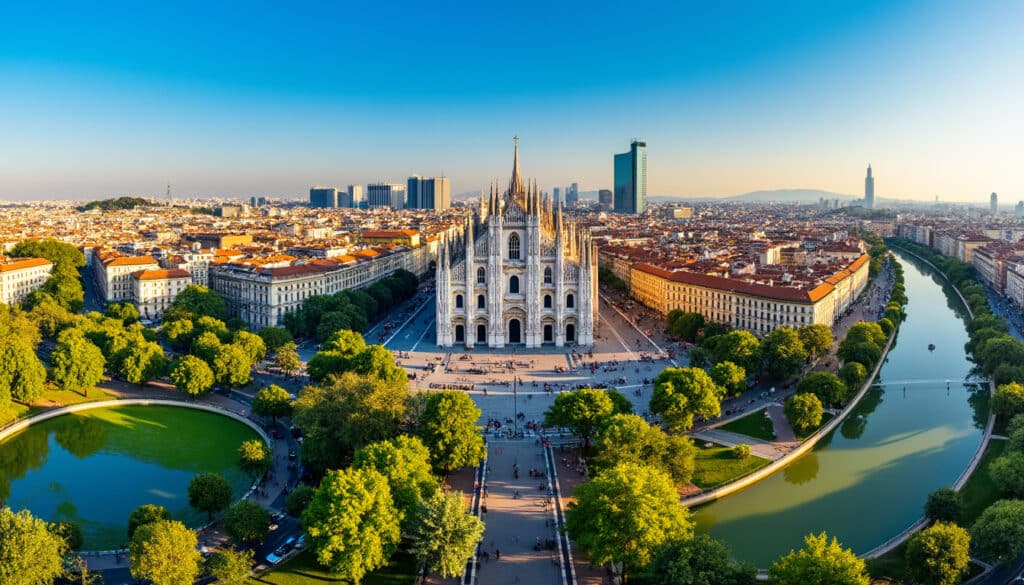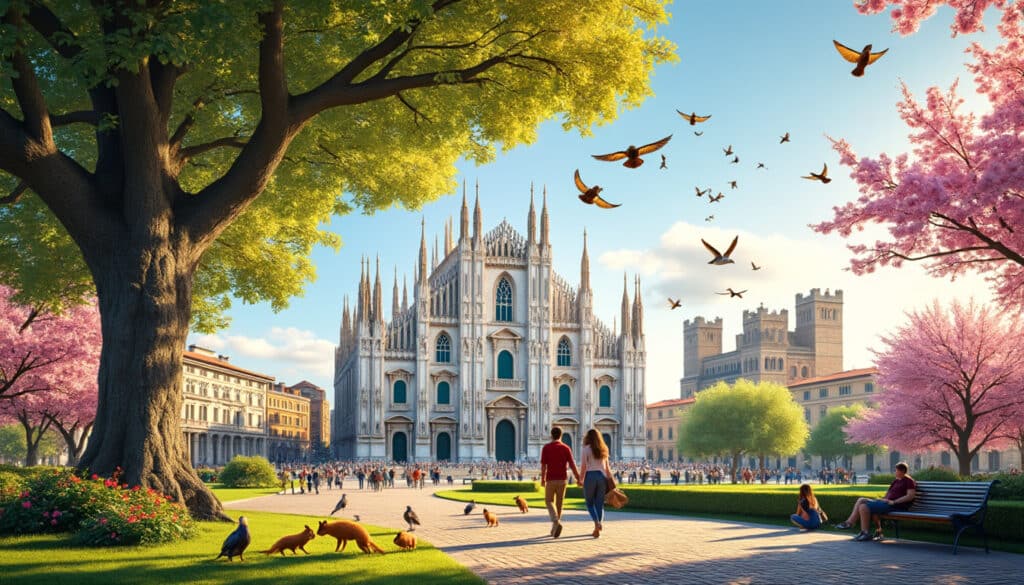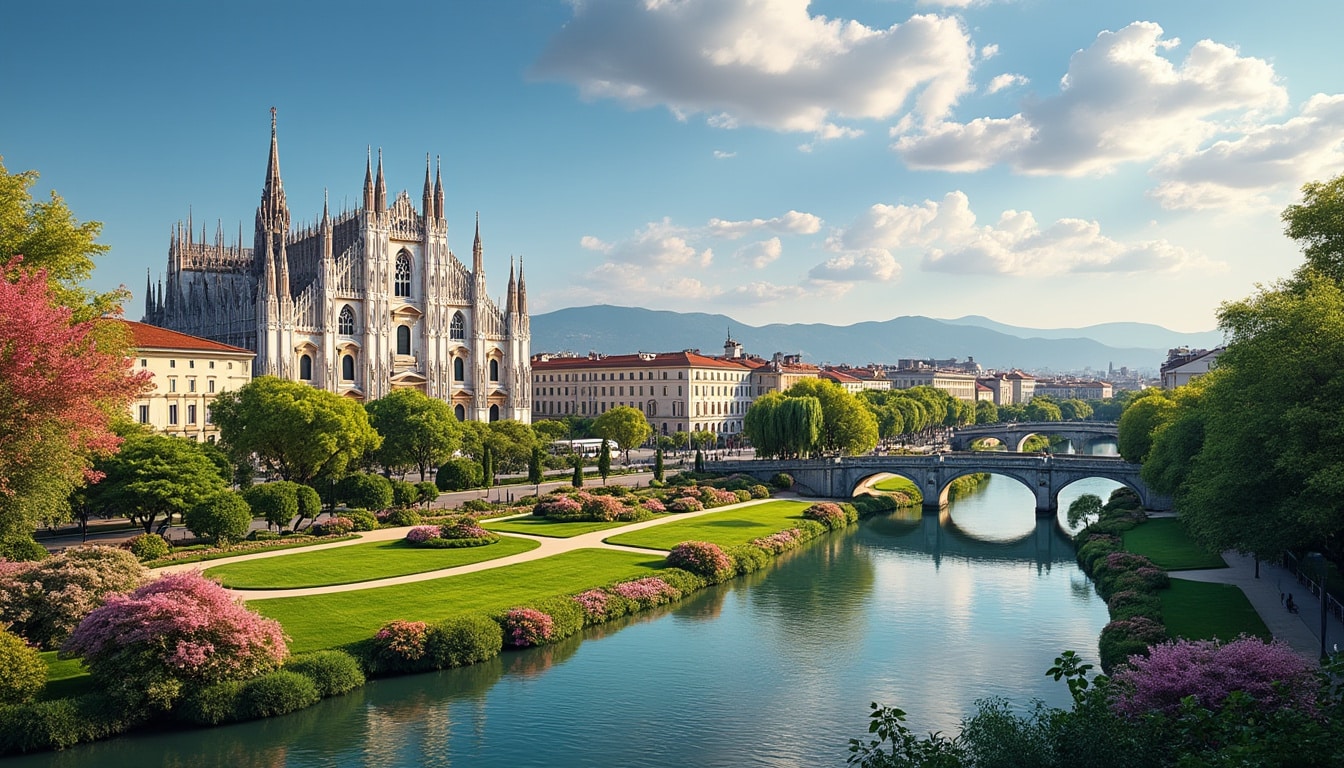Milan, nestled in the heart of northern Italy, is renowned not only for its vibrant fashion scene and historical architecture but also for its unique geographical landscape and natural environments. At first glance, Milan appears to be a bustling urban hub, yet beneath its metropolitan exterior lies a complex tapestry of natural beauty and geographical diversity. This city, with its rich blend of historical significance and modern advancement, offers more than just urban experiences; it presents a captivating journey through its landscapes, waterways, and ecological pursuits. This article delves into the geographical marvels and environmental offerings of Milan in 2025, revealing aspects often overlooked by those focused solely on its cultural and economic highlights.
Milan’s Position in the Po Valley: A Geographical Overview
Located in the vast Po Valley, Milan is strategically positioned amidst a plain that has been termed a “breadbasket” due to its rich agricultural prospects. Historically, this plain, known as “Mediolanum” in Roman times, served as a vital crossroads for trade and military routes. The Po Valley itself is a vast plain, extending across northern Italy, and is surrounded by majestic mountains to the north and extensive river systems, contributing significantly to Milan’s historical and economic development.
This positioning in the Po Basin places Milan approximately 400 feet (122 meters) above sea level, contributing to its humid subtropical climate, characterized by hot, humid summers and cool, damp winters. Snowfalls, once common, have given way to milder winters in recent decades, though they occasionally transform the city into a winter wonderland. The average maximum temperature in the summer hovers around 82°F (28°C), making it a perfect balance between the blazing Mediterranean sun and the cool Alps breeze.
- 🌲 The mix of humidity and subtropical warmth allows varied flora and fauna to thrive.
- 🏞️ Rice fields, once predominant, near the Po River add to the geographical diversity of the region.
- 🏔️ The proximity of the Alps offers breathtaking views and a natural contrast to the expansive plain.
The rivers such as Olona, Lambro, and Seveso play a crucial role in shaping the geography of Milan. These waterways, now mostly running underground, have historically been lifelines providing water for agriculture and supporting Milan’s rapid urban and industrial growth. The presence of these rivers highlights the intricate intertwining of nature and urban development.

Milan’s geographical attributes also include the reduction of the infamous Po Basin fog, thanks to urban development and ecological interventions. The city has worked towards reducing air pollution levels, with initiatives that enhance urban green spaces and protect its natural environments, reshaping how locals and tourists alike experience the city.
The Climate and Eco-friendly Initiatives of Milan
The climate in Milan is not just a matter of weather but an integral aspect of the city’s identity and day-to-day life. Milan’s humid subtropical climate creates hot summers and damp, chilly winters, impacting everything from fashion to food culture. The climate nuances influence the way residents interact with their surroundings, sparking a growing movement towards eco-friendly living and sustainability that has become central to contemporary Milanese life.
In recent years, Milan has robustly pursued eco-friendly Milan initiatives, seeking to harmonize urban development with environmental consciousness. The city’s efforts to lower pollution levels have led to innovative approaches, such as the promotion of Milan Urban Eco Walks that encourage citizens and visitors to explore the city on foot, reducing vehicular emissions and promoting health and well-being.
- 🚶♀️ Milan Urban Eco Walks promote sustainable transport while exploring cultural sites.
- 🚴♂️ The cycling infrastructure expansion has seen a surge in eco-friendly transport options.
- 🛤️ Parks and greenways turning urban spaces into ecological corridors.
Milan’s ambition to provide a cleaner environment is evident in initiatives like the Bosco Verticale or “Vertical Forest,” which integrates lush plant life into the architectural fabric of urban apartments. This innovative approach reflects Milan’s commitment to biodiversity and urban greening, setting benchmarks for sustainable city living. The Bosco Verticale serves as a compelling example of how the city intertwines aesthetic beauty with ecological responsibility, offering a haven for local bird species and greatly enhancing air quality.
The increase in eco-conscious consumers also shapes Milan’s fashion and design industries, which are integrating sustainable materials and practices into their processes. Eco-friendly fashion is now a norm rather than an exception, reflecting a city that respects both tradition and progressive environmental values.
Natural Wonders and Outdoor Escapes Around Milan
Beyond the iconic Duomo and bustling shopping streets, Milan’s natural landscapes beckon adventurers and nature enthusiasts alike. The city’s strategic location provides easy access to a plethora of outdoor escapes that offer breathtaking sceneries and ecological treasures. From the lush parks within the city to the majestic mountains beyond, Milan is a hub for “Milan Green Adventures” and outdoor activities that showcase the city’s commitment to preserving nature alongside urban development.
Parks and gardens are integral to the city’s infrastructure, providing sanctuaries of green amidst the urban landscape. Parco Sempione, adjacent to the historic Castello Sforzesco, offers a sprawling haven of walking paths, elegant arches, and tranquil ponds. It’s a favorite retreat for locals seeking respite from urban hustle, embodying the tranquility of Milan Nature Experience.
- 🌳 Parco Nord Milano, a former industrial site, has transformed into a rich landscape of biodiversity and leisure.
- 🏞️ Idroscalo, once a seaplane port, now a vibrant recreational area for water sports and picnicking.
- 🌷 The Royal Palace Gardens, a historical haven boasting elegant lawns and assorted botanical species.
Milan’s proximity to the Alps and major lakes like Como and Maggiore is often highlighted in the Milan Outdoor Escapes. These regions offer scenic routes for hiking, biking, and even skiing in winter months. The transition from the bustling urban center to tranquil nature is seamless, inviting exploration of the geographic diversity that the Lombardy region boasts.
The embrace of nature is also culturally celebrated through festivals and activities that promote outdoor living and appreciation for the natural world. Events centering on ecological awareness, biodiversity, and sustainability continue to gain popularity, driving home the importance of living green and enjoying the natural beauty that surrounds Milan.
The Interplay of History and Nature in Milan’s Geography
Milan is a city that has, over the centuries, borne witness to myriad changes. The enduring legacy of its historical landmarks juxtaposed with the natural landscape creates a unique geographical narrative. Spanning millennia, the city has evolved from a Celtic settlement to a Roman stronghold, and finally into the global metropolis it is today, with each era leaving indelible marks on its geography.
The historical significance of Milan is evident in its geography, with sites like the Castello Sforzesco and Galleria Vittorio Emanuele II serving as reminders of its storied past. These architectural wonders do not just serve aesthetic purposes; they are situated in ways that reflect the city’s adaptation to geographic and environmental factors. The Castello Sforzesco, for instance, was strategically positioned to leverage the natural defensive advantages provided by surrounding water bodies and elevations.
- 🛡️ Castello Sforzesco: A historical fortress with strategic waterways and gardens.
- 🏛️ The Duomo: Built to embrace Milan’s skyline, it reflects architectural resilience.
- 🕌 Historical canals: Once essential for commerce, they now serve as reminders of innovative engineering.
The city’s historical districts like Brera and Navigli with their cobblestone streets and ancient canals, underscore the intersection of history and geography. These areas, while modernized, have preserved much of their historical charm, offering an authentic Milan sense experience that is inextricably linked to the city’s natural and architectural landscapes.
Milan’s commitment to preserving its historical and environmental integrity is demonstrated through its urban planning strategies that balance development and conservation. Whether through the protection of historic sites or the cultivation of urban parks, Milan stands as a beacon of how traditional aesthetics and modern environmental efforts can vividly coexist.
Future Prospects: A Sustainable and Resilient Milan
Looking towards the future, Milan is poised on the brink of groundbreaking developments in sustainability and urban resilience. As the city continues to evolve, it serves as a model of ecological and geographical innovation, offering a roadmap for other global cities seeking to tackle similar challenges.
Among these initiatives is the ambitious urban planning project Current Milan, aimed at crafting a more sustainable urban environment. This long-term plan focuses on increasing green spaces, emphasizing renewable energy sources, and further reducing carbon footprints through smart technologies and sustainable transportation networks. Initiatives like Milan Eco Tours advocate for eco-centric tourism that encourages visitors to immerse themselves in the natural beauty and sustainable practices the city upholds.
- 🌍 Renewable Energy: Emphasizing solar and wind to power urban infrastructures.
- 🚁 Urban Farming: Initiatives promoting local produce within city landscapes.
- 🌆 Smart Technology: Integrating digital tools for efficient urban management.
Urban resilience plans also include infrastructural upgrades such as flood defenses around the Po River and enhanced public transportation systems to combat climate change effects. By spearheading these efforts, Milan is not just preserving its natural and historical legacy but actively shaping a future that harmonizes urban life with natural ecosystems.
The emphasis is also on community involvement and education. Programs aimed at increasing awareness of biodiversity and ecological practices in urban environments are being integrated into educational institutions, ensuring that future generations stay rooted in their environmental responsibilities.
Milan’s journey towards becoming an eco-friendly icon and geographical wonder continues to inspire both residents and visitors. As the city strides forth with cutting-edge projects and green initiatives, it solidifies its status as a leader in sustainable urban development, combining the past and present for a brighter, more verdant future.
FAQ
- What’s the climate like in Milan? Milan experiences a humid subtropical climate with hot summers and chilly winters, perfect for exploring its mix of urban and natural environments.
- What are the best natural attractions in Milan? Parco Sempione, the Alpine views, and nearby lakes like Como offer fantastic natural escapes for both residents and visitors.
- How is Milan addressing environmental concerns? Milan is implementing sustainable practices through green architecture, ecological initiatives, and extensive urban green spaces.
- What role does geography play in Milan’s economy? Milan’s position in the Po Valley is pivotal for agriculture, trade routes, and even tourism, leveraging its scenic landscapes and historical sites.
- Are there sustainable fashion options in Milan? Absolutely! Milan’s fashion industry is increasingly integrating sustainable practices and materials, reflecting the city’s commitment to eco-friendly lifestyles.

Geographical features of Milan
Milan, Italy’s bustling cosmopolitan hub, is a city of remarkable contrasts and rich history. Known for its fashion prowess and cultural landmarks, the city’s geographical features offer a fascinating backdrop to its urban splendor. Set in the expansive Po Basin…

Location and coordinates of Milan
Discover the rich tapestry of Milan, a city celebrated for its blend of modernity and tradition. Ever wondered where exactly this fashion metropolis is located on the globe? This article delves into the geographic coordinates and pivotal elements that shape…

🌿 Milan, a city globally acclaimed for its rich tapestry of fashion, art, and architecture, also conceals an awe-inspiring realm of nature and wildlife. This paradoxical urban jungle promises an exhilarating escapade into lush termini where nature enthusiasts can discover…


